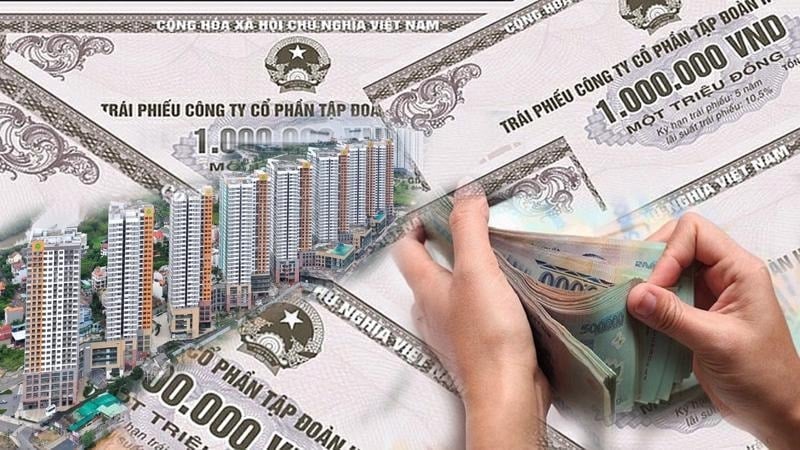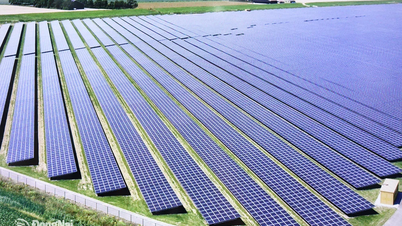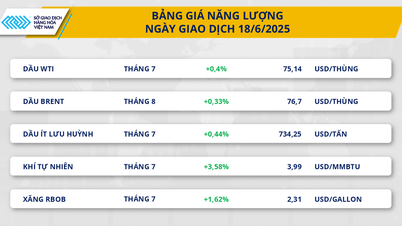Stronger trend between liquidity and credit pressure
The activity of buying back corporate bonds before maturity is taking place in the banking system, reflecting an accelerating financial trend in the context of the bond market still facing many risks in terms of liquidity and investor confidence.
According to a report from FiinRatings, in May 2025 alone, the total value of corporate bonds bought back before maturity reached about VND18,900 billion, a sharp increase of 53.3% compared to April and an increase of 27.4% compared to the same period last year.
Notably, banking and real estate groups accounted for the majority of the acquisition momentum, accounting for 45.6% and 53.2%, respectively.
Techcombank is a prominent name in this wave. On June 11, this bank spent VND5,000 billion to buy back the entire TCBL2427005 bond lot, just one year after the issuance date. This is the fourth time Techcombank has settled bonds before maturity in 2025, bringing the total value of bonds bought back to more than VND12,500 billion, demonstrating a proactive strategy of restructuring capital sources and reducing medium- and long-term debt pressure.
Similarly, Bac A Bank has also continuously announced early buybacks of large-value bonds. Most recently, on June 10, the bank settled the BABL2427005 bond lot worth VND500 billion after only one year of issuance.
Previously, in May, the bank also bought back two other bonds, both with three-year terms, showing its determination to "clean up" early maturing debts in its bond portfolio.
Vietnam Maritime Bank (MSB) is also not out of the game, having just bought back a batch of bonds worth VND800 billion two years ahead of schedule. Meanwhile, other “big guys” such as MB and BIDV have also announced plans to settle large-scale bonds ahead of schedule.
Notably, BIDV plans to spend more than VND12,271 billion to buy back all bonds issued from 2018 to 2024, maturing in the period 2030-2031.
Analysts say this wave of bond buybacks shows that banks are proactively "cleaning up" their balance sheets and reducing debt obligations in a context where the financial market remains unstable and liquidity pressure tends to increase.
In addition, early repayment can also contribute to improving credit ratings and increasing credibility with investors, especially in the increasingly tightening legal environment of the bond market.

Why are banks rushing to buy back bonds before maturity?
According to experts from VNDirect Securities Company, the recent wave of banks buying back bonds before maturity is not accidental. The core reason lies in the fact that the banking system is in a state of excess liquidity.
A large amount of idle money, while credit output is still tightly controlled by macro factors such as interest rates, weak investment demand and potential bad debt risks, forces many banks to find ways to use capital more effectively.
Buying back bonds before maturity becomes a “win-win” solution: it helps banks reduce excess capital and improve their capital adequacy ratio (CAR), thereby ensuring compliance with the strict requirements of the State Bank of Vietnam (SBV).
In addition to liquidity, analysts also believe that the goal of restructuring bond terms and interest rates is also an important reason for this move. From October 1, 2023, according to regulations of the State Bank of Vietnam, the ratio of short-term capital used for medium- and long-term loans will decrease from 34% to 30%.
This forces banks to change their bond issuance strategy to ensure safety ratios. Buying back short-term bonds (under 5 years) will open up "room" to issue new bonds with longer terms (over 5 years), which will be counted in Tier 2 capital, an important part of the capital structure of commercial banks.
Market reality shows that many banks are following this direction: buying back old bonds with a term of 2-3 years, while simultaneously issuing new batches of bonds with a term of 5-10 years.
This move is not only in line with legal regulations but also helps banks reallocate debt repayment obligations, avoiding short-term maturities that can put great pressure on liquidity if the market fluctuates.
In addition, buying back bonds on time or before maturity also contributes to strengthening the bank's reputation, financial capacity and initiative in the eyes of investors.
BIDV Bank representative emphasized that the bond repurchase is to fulfill the commitment to bondholders, affirm financial capacity and facilitate new issuance plans in the future.
However, experts also noted that banks need to be transparent about the capital sources used to buy back bonds, as well as announce a new issuance roadmap if any.
Dr. Le Xuan Nghia, a banking and finance expert, warned that if the acquisition takes place quietly and without clear information, it could cause investors to worry about the real reason behind the move, affecting market confidence.
The “last straw” may come from the lack of information transparency, especially in the context of confidence in the bond market not fully recovering from previous “crises of confidence”.
On the stock market side, the fact that banks proactively buy back bonds from their reserve funds and follow the correct procedures can send a positive signal. Investors will see this as a sign of good financial management capacity, thereby supporting bank stock prices in the short term.
In short, behind the wave of early bond buybacks is not only the story of excess liquidity, but also the strategy of adjusting capital structure, complying with new regulations and creating a foundation for sustainable development in the next phase.
Source: https://baodaknong.vn/chay-dua-tat-toan-trai-phieu-ngan-hang-dang-toan-tinh-dieu-gi-255980.html






































































































Comment (0)